Report on Managing Cultural Differences Between India and Australia
VerifiedAdded on 2023/06/06
|12
|2403
|91
Report
AI Summary
This report provides a comprehensive analysis of the cultural differences between India and Australia, utilizing Hofstede's cultural dimensions to highlight key distinctions. The report examines power distance, individualism, masculinity, uncertainty avoidance, long-term orientation, and indulgence, offering a detailed comparison of each dimension between the two countries. It then identifies potential management issues that may arise due to these cultural differences, such as communication styles, leadership approaches, and employee expectations. Furthermore, the report offers practical recommendations for mitigating these challenges, including fostering cultural understanding, developing cross-cultural training programs, and adapting management practices to suit the specific cultural context. The conclusion emphasizes the importance of cultural sensitivity for successful global business operations.
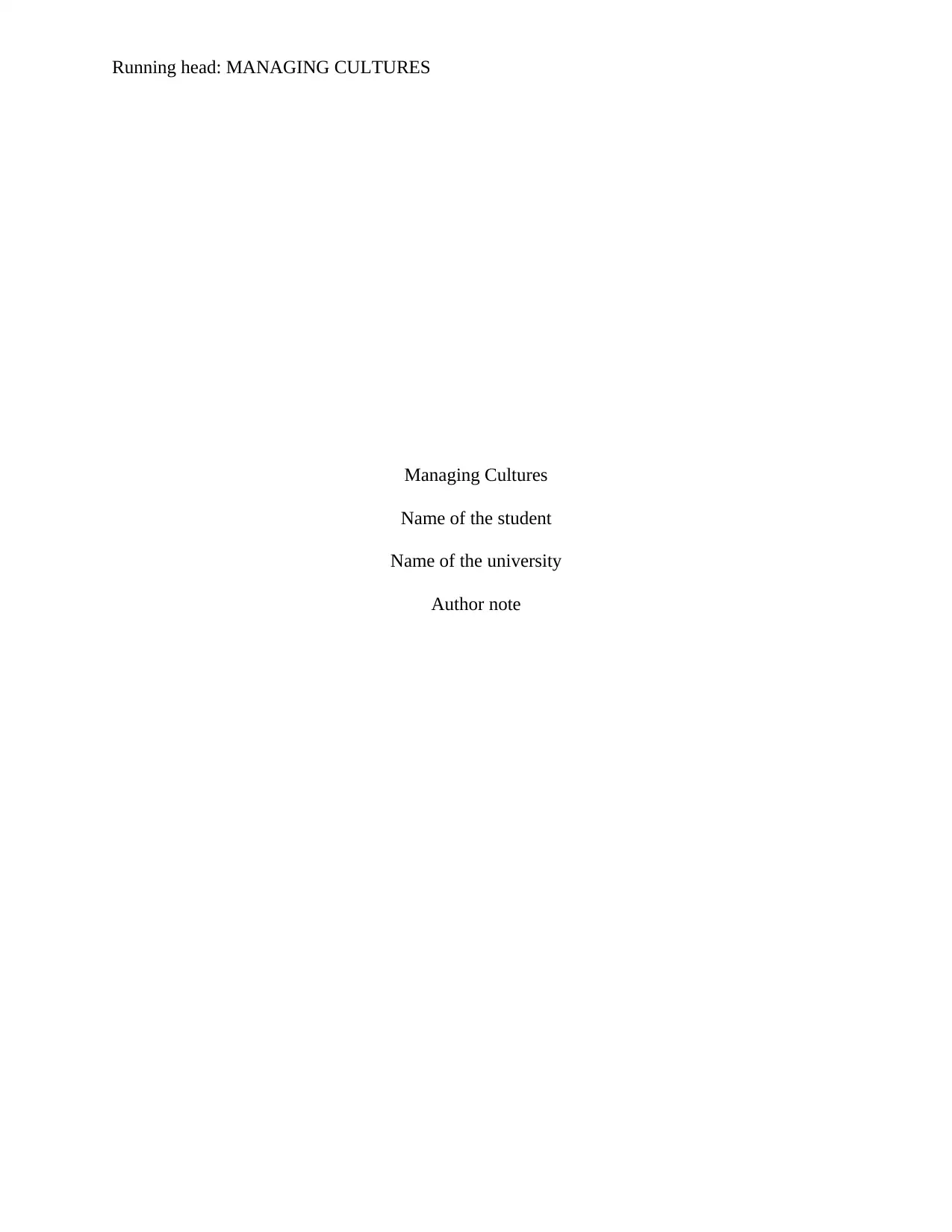
Running head: MANAGING CULTURES
Managing Cultures
Name of the student
Name of the university
Author note
Managing Cultures
Name of the student
Name of the university
Author note
Paraphrase This Document
Need a fresh take? Get an instant paraphrase of this document with our AI Paraphraser
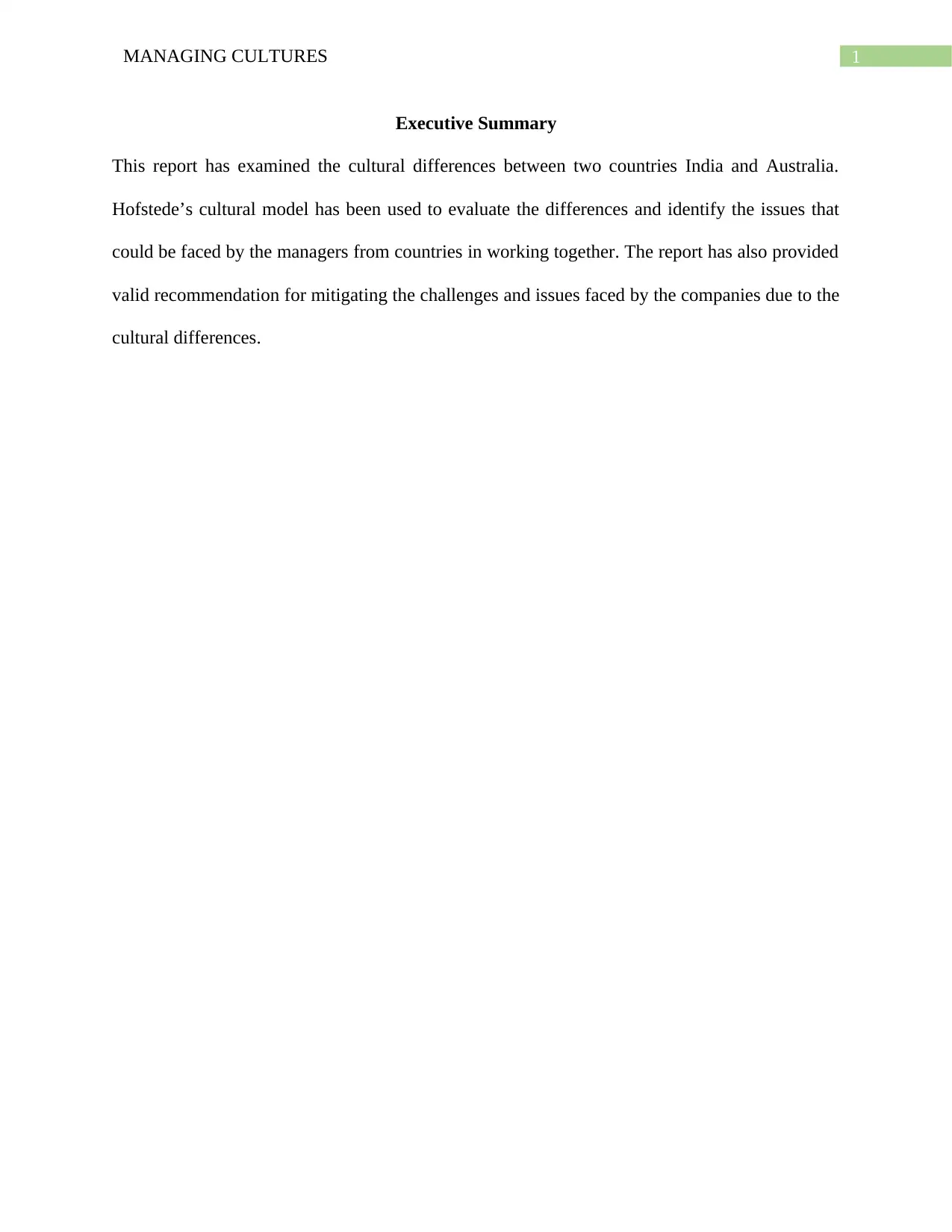
1MANAGING CULTURES
Executive Summary
This report has examined the cultural differences between two countries India and Australia.
Hofstede’s cultural model has been used to evaluate the differences and identify the issues that
could be faced by the managers from countries in working together. The report has also provided
valid recommendation for mitigating the challenges and issues faced by the companies due to the
cultural differences.
Executive Summary
This report has examined the cultural differences between two countries India and Australia.
Hofstede’s cultural model has been used to evaluate the differences and identify the issues that
could be faced by the managers from countries in working together. The report has also provided
valid recommendation for mitigating the challenges and issues faced by the companies due to the
cultural differences.
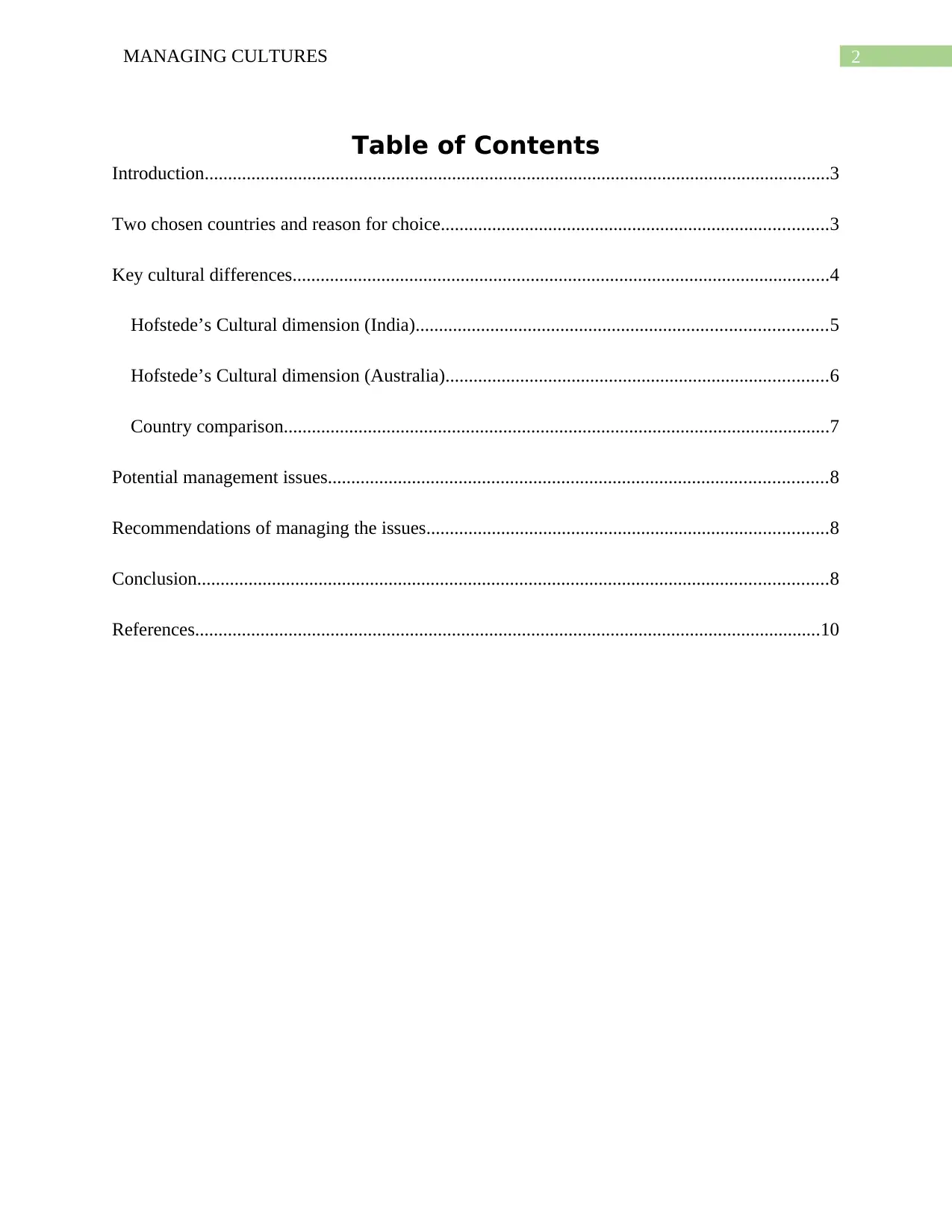
2MANAGING CULTURES
Table of Contents
Introduction......................................................................................................................................3
Two chosen countries and reason for choice...................................................................................3
Key cultural differences...................................................................................................................4
Hofstede’s Cultural dimension (India)........................................................................................5
Hofstede’s Cultural dimension (Australia)..................................................................................6
Country comparison.....................................................................................................................7
Potential management issues...........................................................................................................8
Recommendations of managing the issues......................................................................................8
Conclusion.......................................................................................................................................8
References......................................................................................................................................10
Table of Contents
Introduction......................................................................................................................................3
Two chosen countries and reason for choice...................................................................................3
Key cultural differences...................................................................................................................4
Hofstede’s Cultural dimension (India)........................................................................................5
Hofstede’s Cultural dimension (Australia)..................................................................................6
Country comparison.....................................................................................................................7
Potential management issues...........................................................................................................8
Recommendations of managing the issues......................................................................................8
Conclusion.......................................................................................................................................8
References......................................................................................................................................10
⊘ This is a preview!⊘
Do you want full access?
Subscribe today to unlock all pages.

Trusted by 1+ million students worldwide
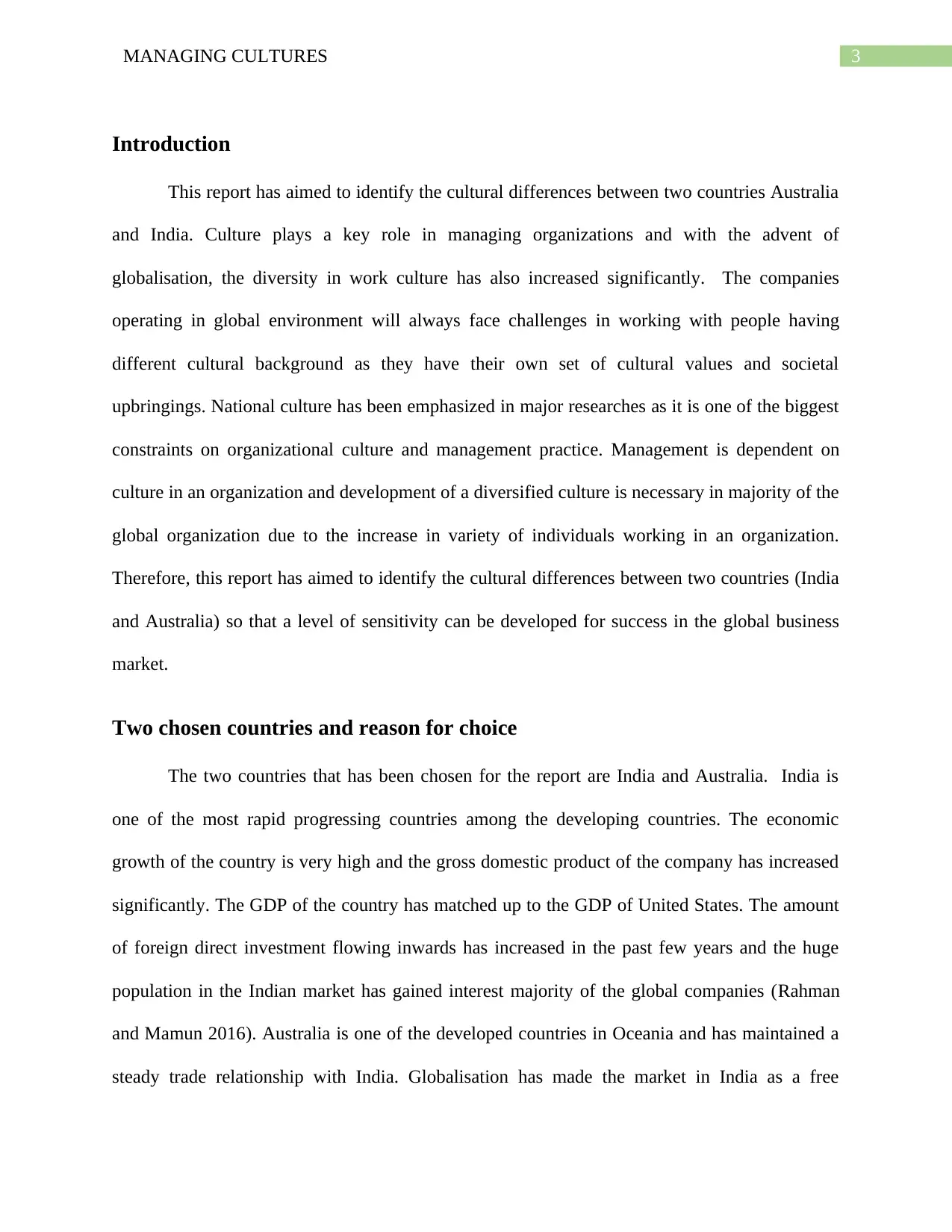
3MANAGING CULTURES
Introduction
This report has aimed to identify the cultural differences between two countries Australia
and India. Culture plays a key role in managing organizations and with the advent of
globalisation, the diversity in work culture has also increased significantly. The companies
operating in global environment will always face challenges in working with people having
different cultural background as they have their own set of cultural values and societal
upbringings. National culture has been emphasized in major researches as it is one of the biggest
constraints on organizational culture and management practice. Management is dependent on
culture in an organization and development of a diversified culture is necessary in majority of the
global organization due to the increase in variety of individuals working in an organization.
Therefore, this report has aimed to identify the cultural differences between two countries (India
and Australia) so that a level of sensitivity can be developed for success in the global business
market.
Two chosen countries and reason for choice
The two countries that has been chosen for the report are India and Australia. India is
one of the most rapid progressing countries among the developing countries. The economic
growth of the country is very high and the gross domestic product of the company has increased
significantly. The GDP of the country has matched up to the GDP of United States. The amount
of foreign direct investment flowing inwards has increased in the past few years and the huge
population in the Indian market has gained interest majority of the global companies (Rahman
and Mamun 2016). Australia is one of the developed countries in Oceania and has maintained a
steady trade relationship with India. Globalisation has made the market in India as a free
Introduction
This report has aimed to identify the cultural differences between two countries Australia
and India. Culture plays a key role in managing organizations and with the advent of
globalisation, the diversity in work culture has also increased significantly. The companies
operating in global environment will always face challenges in working with people having
different cultural background as they have their own set of cultural values and societal
upbringings. National culture has been emphasized in major researches as it is one of the biggest
constraints on organizational culture and management practice. Management is dependent on
culture in an organization and development of a diversified culture is necessary in majority of the
global organization due to the increase in variety of individuals working in an organization.
Therefore, this report has aimed to identify the cultural differences between two countries (India
and Australia) so that a level of sensitivity can be developed for success in the global business
market.
Two chosen countries and reason for choice
The two countries that has been chosen for the report are India and Australia. India is
one of the most rapid progressing countries among the developing countries. The economic
growth of the country is very high and the gross domestic product of the company has increased
significantly. The GDP of the country has matched up to the GDP of United States. The amount
of foreign direct investment flowing inwards has increased in the past few years and the huge
population in the Indian market has gained interest majority of the global companies (Rahman
and Mamun 2016). Australia is one of the developed countries in Oceania and has maintained a
steady trade relationship with India. Globalisation has made the market in India as a free
Paraphrase This Document
Need a fresh take? Get an instant paraphrase of this document with our AI Paraphraser
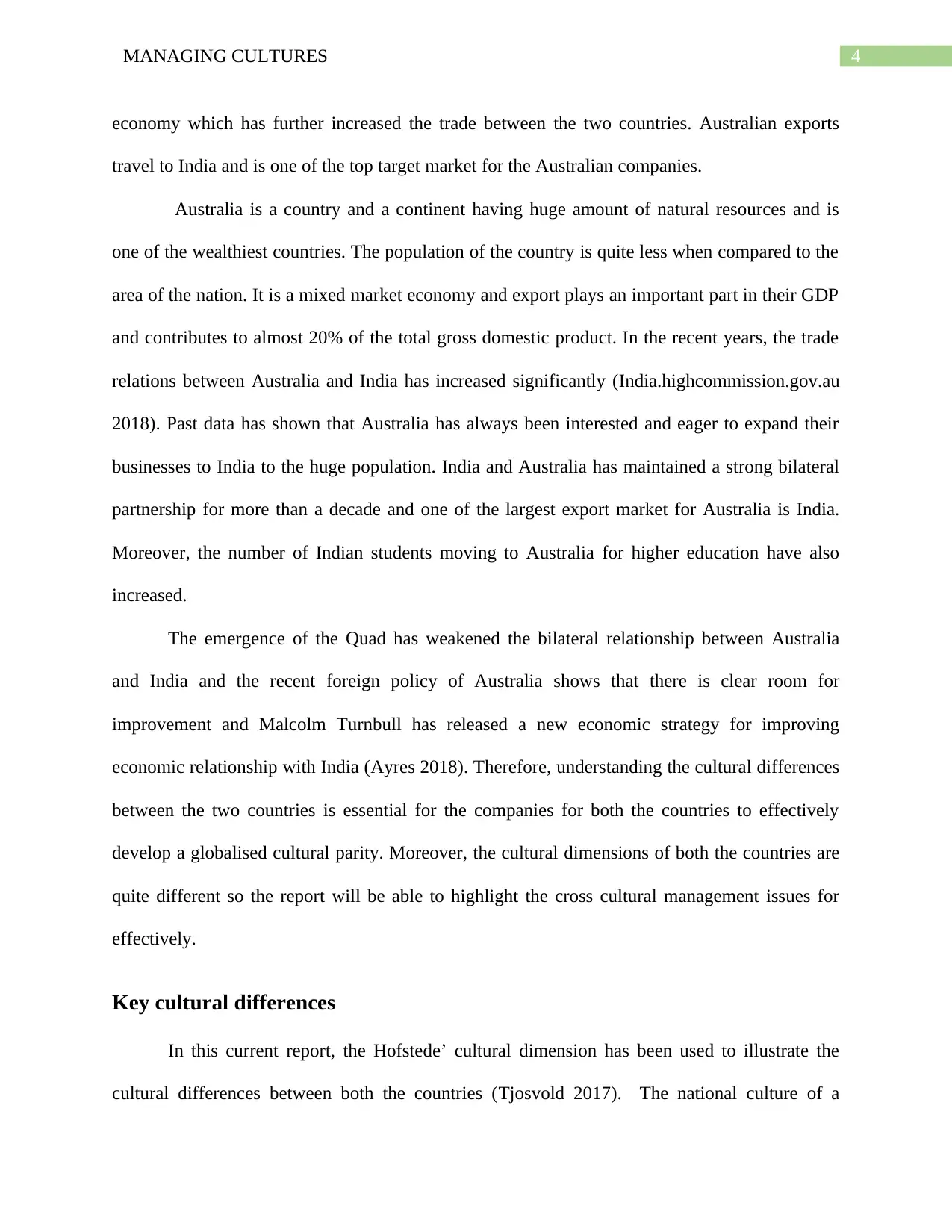
4MANAGING CULTURES
economy which has further increased the trade between the two countries. Australian exports
travel to India and is one of the top target market for the Australian companies.
Australia is a country and a continent having huge amount of natural resources and is
one of the wealthiest countries. The population of the country is quite less when compared to the
area of the nation. It is a mixed market economy and export plays an important part in their GDP
and contributes to almost 20% of the total gross domestic product. In the recent years, the trade
relations between Australia and India has increased significantly (India.highcommission.gov.au
2018). Past data has shown that Australia has always been interested and eager to expand their
businesses to India to the huge population. India and Australia has maintained a strong bilateral
partnership for more than a decade and one of the largest export market for Australia is India.
Moreover, the number of Indian students moving to Australia for higher education have also
increased.
The emergence of the Quad has weakened the bilateral relationship between Australia
and India and the recent foreign policy of Australia shows that there is clear room for
improvement and Malcolm Turnbull has released a new economic strategy for improving
economic relationship with India (Ayres 2018). Therefore, understanding the cultural differences
between the two countries is essential for the companies for both the countries to effectively
develop a globalised cultural parity. Moreover, the cultural dimensions of both the countries are
quite different so the report will be able to highlight the cross cultural management issues for
effectively.
Key cultural differences
In this current report, the Hofstede’ cultural dimension has been used to illustrate the
cultural differences between both the countries (Tjosvold 2017). The national culture of a
economy which has further increased the trade between the two countries. Australian exports
travel to India and is one of the top target market for the Australian companies.
Australia is a country and a continent having huge amount of natural resources and is
one of the wealthiest countries. The population of the country is quite less when compared to the
area of the nation. It is a mixed market economy and export plays an important part in their GDP
and contributes to almost 20% of the total gross domestic product. In the recent years, the trade
relations between Australia and India has increased significantly (India.highcommission.gov.au
2018). Past data has shown that Australia has always been interested and eager to expand their
businesses to India to the huge population. India and Australia has maintained a strong bilateral
partnership for more than a decade and one of the largest export market for Australia is India.
Moreover, the number of Indian students moving to Australia for higher education have also
increased.
The emergence of the Quad has weakened the bilateral relationship between Australia
and India and the recent foreign policy of Australia shows that there is clear room for
improvement and Malcolm Turnbull has released a new economic strategy for improving
economic relationship with India (Ayres 2018). Therefore, understanding the cultural differences
between the two countries is essential for the companies for both the countries to effectively
develop a globalised cultural parity. Moreover, the cultural dimensions of both the countries are
quite different so the report will be able to highlight the cross cultural management issues for
effectively.
Key cultural differences
In this current report, the Hofstede’ cultural dimension has been used to illustrate the
cultural differences between both the countries (Tjosvold 2017). The national culture of a
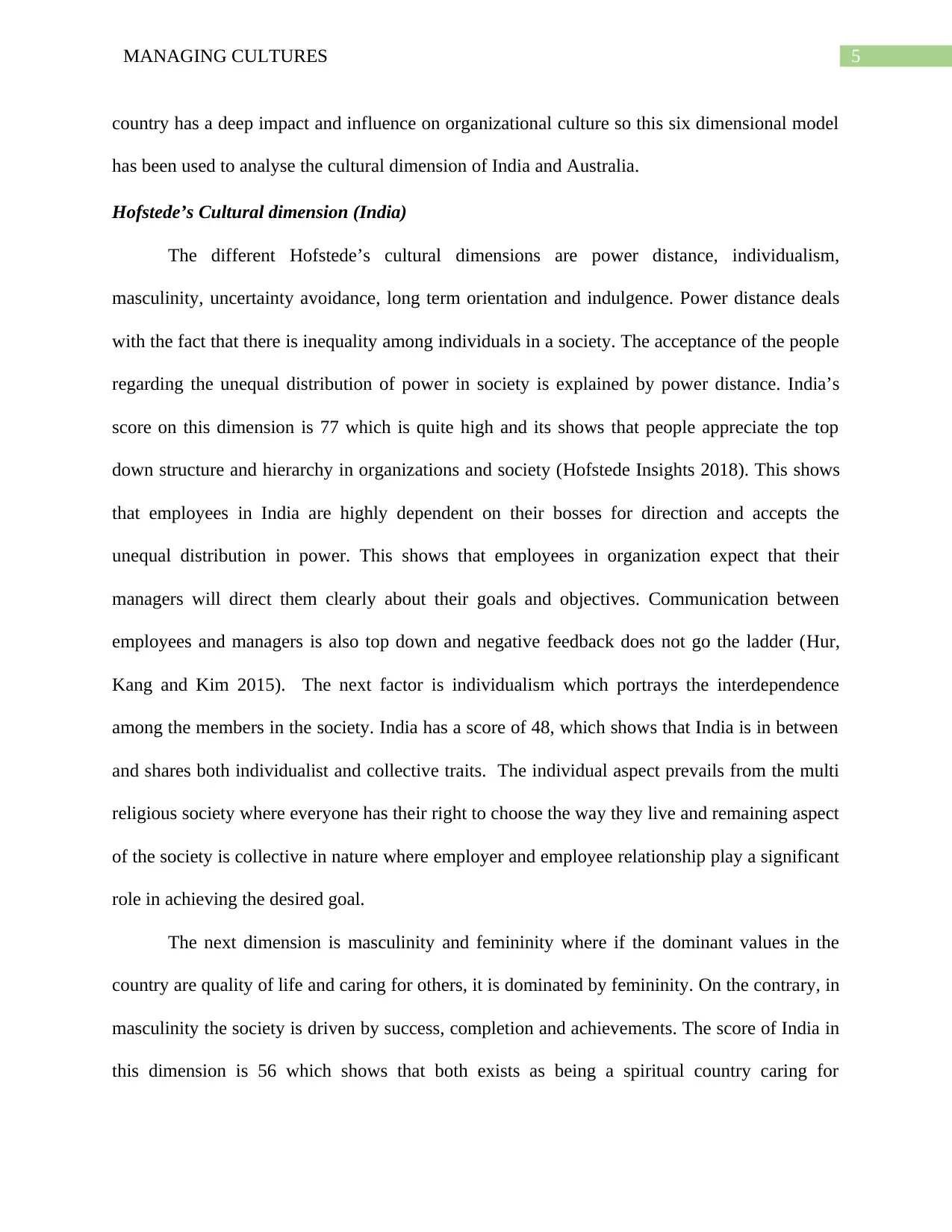
5MANAGING CULTURES
country has a deep impact and influence on organizational culture so this six dimensional model
has been used to analyse the cultural dimension of India and Australia.
Hofstede’s Cultural dimension (India)
The different Hofstede’s cultural dimensions are power distance, individualism,
masculinity, uncertainty avoidance, long term orientation and indulgence. Power distance deals
with the fact that there is inequality among individuals in a society. The acceptance of the people
regarding the unequal distribution of power in society is explained by power distance. India’s
score on this dimension is 77 which is quite high and its shows that people appreciate the top
down structure and hierarchy in organizations and society (Hofstede Insights 2018). This shows
that employees in India are highly dependent on their bosses for direction and accepts the
unequal distribution in power. This shows that employees in organization expect that their
managers will direct them clearly about their goals and objectives. Communication between
employees and managers is also top down and negative feedback does not go the ladder (Hur,
Kang and Kim 2015). The next factor is individualism which portrays the interdependence
among the members in the society. India has a score of 48, which shows that India is in between
and shares both individualist and collective traits. The individual aspect prevails from the multi
religious society where everyone has their right to choose the way they live and remaining aspect
of the society is collective in nature where employer and employee relationship play a significant
role in achieving the desired goal.
The next dimension is masculinity and femininity where if the dominant values in the
country are quality of life and caring for others, it is dominated by femininity. On the contrary, in
masculinity the society is driven by success, completion and achievements. The score of India in
this dimension is 56 which shows that both exists as being a spiritual country caring for
country has a deep impact and influence on organizational culture so this six dimensional model
has been used to analyse the cultural dimension of India and Australia.
Hofstede’s Cultural dimension (India)
The different Hofstede’s cultural dimensions are power distance, individualism,
masculinity, uncertainty avoidance, long term orientation and indulgence. Power distance deals
with the fact that there is inequality among individuals in a society. The acceptance of the people
regarding the unequal distribution of power in society is explained by power distance. India’s
score on this dimension is 77 which is quite high and its shows that people appreciate the top
down structure and hierarchy in organizations and society (Hofstede Insights 2018). This shows
that employees in India are highly dependent on their bosses for direction and accepts the
unequal distribution in power. This shows that employees in organization expect that their
managers will direct them clearly about their goals and objectives. Communication between
employees and managers is also top down and negative feedback does not go the ladder (Hur,
Kang and Kim 2015). The next factor is individualism which portrays the interdependence
among the members in the society. India has a score of 48, which shows that India is in between
and shares both individualist and collective traits. The individual aspect prevails from the multi
religious society where everyone has their right to choose the way they live and remaining aspect
of the society is collective in nature where employer and employee relationship play a significant
role in achieving the desired goal.
The next dimension is masculinity and femininity where if the dominant values in the
country are quality of life and caring for others, it is dominated by femininity. On the contrary, in
masculinity the society is driven by success, completion and achievements. The score of India in
this dimension is 56 which shows that both exists as being a spiritual country caring for
⊘ This is a preview!⊘
Do you want full access?
Subscribe today to unlock all pages.

Trusted by 1+ million students worldwide
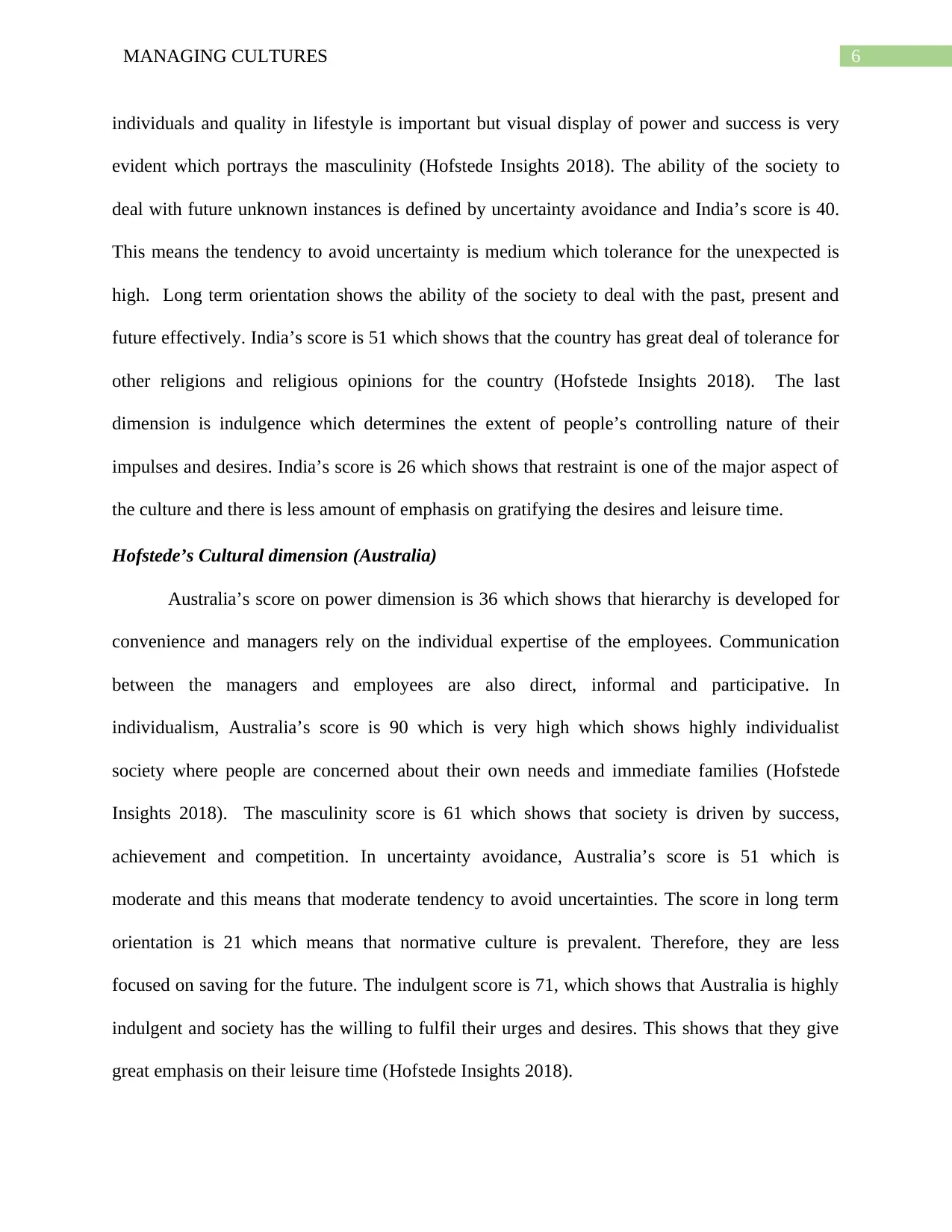
6MANAGING CULTURES
individuals and quality in lifestyle is important but visual display of power and success is very
evident which portrays the masculinity (Hofstede Insights 2018). The ability of the society to
deal with future unknown instances is defined by uncertainty avoidance and India’s score is 40.
This means the tendency to avoid uncertainty is medium which tolerance for the unexpected is
high. Long term orientation shows the ability of the society to deal with the past, present and
future effectively. India’s score is 51 which shows that the country has great deal of tolerance for
other religions and religious opinions for the country (Hofstede Insights 2018). The last
dimension is indulgence which determines the extent of people’s controlling nature of their
impulses and desires. India’s score is 26 which shows that restraint is one of the major aspect of
the culture and there is less amount of emphasis on gratifying the desires and leisure time.
Hofstede’s Cultural dimension (Australia)
Australia’s score on power dimension is 36 which shows that hierarchy is developed for
convenience and managers rely on the individual expertise of the employees. Communication
between the managers and employees are also direct, informal and participative. In
individualism, Australia’s score is 90 which is very high which shows highly individualist
society where people are concerned about their own needs and immediate families (Hofstede
Insights 2018). The masculinity score is 61 which shows that society is driven by success,
achievement and competition. In uncertainty avoidance, Australia’s score is 51 which is
moderate and this means that moderate tendency to avoid uncertainties. The score in long term
orientation is 21 which means that normative culture is prevalent. Therefore, they are less
focused on saving for the future. The indulgent score is 71, which shows that Australia is highly
indulgent and society has the willing to fulfil their urges and desires. This shows that they give
great emphasis on their leisure time (Hofstede Insights 2018).
individuals and quality in lifestyle is important but visual display of power and success is very
evident which portrays the masculinity (Hofstede Insights 2018). The ability of the society to
deal with future unknown instances is defined by uncertainty avoidance and India’s score is 40.
This means the tendency to avoid uncertainty is medium which tolerance for the unexpected is
high. Long term orientation shows the ability of the society to deal with the past, present and
future effectively. India’s score is 51 which shows that the country has great deal of tolerance for
other religions and religious opinions for the country (Hofstede Insights 2018). The last
dimension is indulgence which determines the extent of people’s controlling nature of their
impulses and desires. India’s score is 26 which shows that restraint is one of the major aspect of
the culture and there is less amount of emphasis on gratifying the desires and leisure time.
Hofstede’s Cultural dimension (Australia)
Australia’s score on power dimension is 36 which shows that hierarchy is developed for
convenience and managers rely on the individual expertise of the employees. Communication
between the managers and employees are also direct, informal and participative. In
individualism, Australia’s score is 90 which is very high which shows highly individualist
society where people are concerned about their own needs and immediate families (Hofstede
Insights 2018). The masculinity score is 61 which shows that society is driven by success,
achievement and competition. In uncertainty avoidance, Australia’s score is 51 which is
moderate and this means that moderate tendency to avoid uncertainties. The score in long term
orientation is 21 which means that normative culture is prevalent. Therefore, they are less
focused on saving for the future. The indulgent score is 71, which shows that Australia is highly
indulgent and society has the willing to fulfil their urges and desires. This shows that they give
great emphasis on their leisure time (Hofstede Insights 2018).
Paraphrase This Document
Need a fresh take? Get an instant paraphrase of this document with our AI Paraphraser
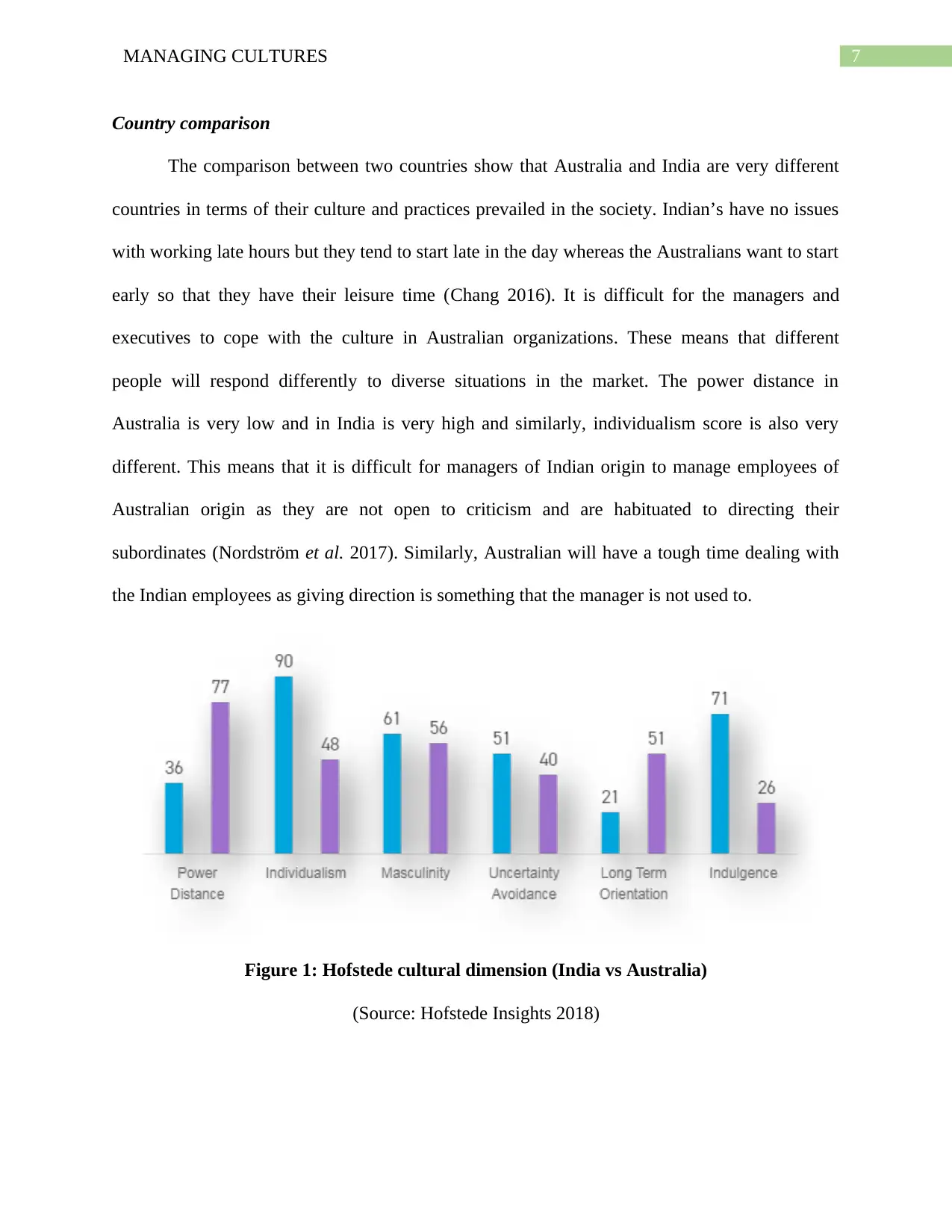
7MANAGING CULTURES
Country comparison
The comparison between two countries show that Australia and India are very different
countries in terms of their culture and practices prevailed in the society. Indian’s have no issues
with working late hours but they tend to start late in the day whereas the Australians want to start
early so that they have their leisure time (Chang 2016). It is difficult for the managers and
executives to cope with the culture in Australian organizations. These means that different
people will respond differently to diverse situations in the market. The power distance in
Australia is very low and in India is very high and similarly, individualism score is also very
different. This means that it is difficult for managers of Indian origin to manage employees of
Australian origin as they are not open to criticism and are habituated to directing their
subordinates (Nordström et al. 2017). Similarly, Australian will have a tough time dealing with
the Indian employees as giving direction is something that the manager is not used to.
Figure 1: Hofstede cultural dimension (India vs Australia)
(Source: Hofstede Insights 2018)
Country comparison
The comparison between two countries show that Australia and India are very different
countries in terms of their culture and practices prevailed in the society. Indian’s have no issues
with working late hours but they tend to start late in the day whereas the Australians want to start
early so that they have their leisure time (Chang 2016). It is difficult for the managers and
executives to cope with the culture in Australian organizations. These means that different
people will respond differently to diverse situations in the market. The power distance in
Australia is very low and in India is very high and similarly, individualism score is also very
different. This means that it is difficult for managers of Indian origin to manage employees of
Australian origin as they are not open to criticism and are habituated to directing their
subordinates (Nordström et al. 2017). Similarly, Australian will have a tough time dealing with
the Indian employees as giving direction is something that the manager is not used to.
Figure 1: Hofstede cultural dimension (India vs Australia)
(Source: Hofstede Insights 2018)
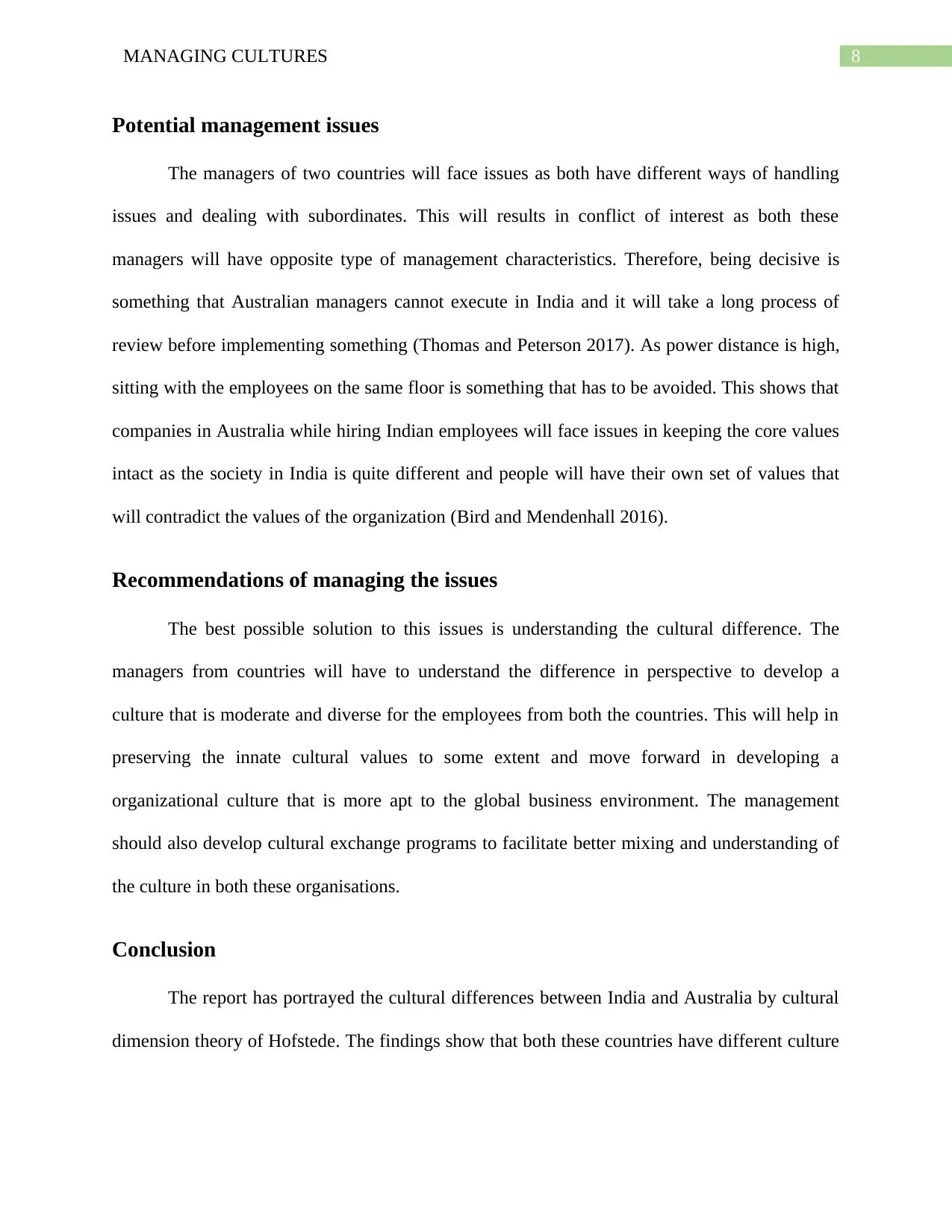
8MANAGING CULTURES
Potential management issues
The managers of two countries will face issues as both have different ways of handling
issues and dealing with subordinates. This will results in conflict of interest as both these
managers will have opposite type of management characteristics. Therefore, being decisive is
something that Australian managers cannot execute in India and it will take a long process of
review before implementing something (Thomas and Peterson 2017). As power distance is high,
sitting with the employees on the same floor is something that has to be avoided. This shows that
companies in Australia while hiring Indian employees will face issues in keeping the core values
intact as the society in India is quite different and people will have their own set of values that
will contradict the values of the organization (Bird and Mendenhall 2016).
Recommendations of managing the issues
The best possible solution to this issues is understanding the cultural difference. The
managers from countries will have to understand the difference in perspective to develop a
culture that is moderate and diverse for the employees from both the countries. This will help in
preserving the innate cultural values to some extent and move forward in developing a
organizational culture that is more apt to the global business environment. The management
should also develop cultural exchange programs to facilitate better mixing and understanding of
the culture in both these organisations.
Conclusion
The report has portrayed the cultural differences between India and Australia by cultural
dimension theory of Hofstede. The findings show that both these countries have different culture
Potential management issues
The managers of two countries will face issues as both have different ways of handling
issues and dealing with subordinates. This will results in conflict of interest as both these
managers will have opposite type of management characteristics. Therefore, being decisive is
something that Australian managers cannot execute in India and it will take a long process of
review before implementing something (Thomas and Peterson 2017). As power distance is high,
sitting with the employees on the same floor is something that has to be avoided. This shows that
companies in Australia while hiring Indian employees will face issues in keeping the core values
intact as the society in India is quite different and people will have their own set of values that
will contradict the values of the organization (Bird and Mendenhall 2016).
Recommendations of managing the issues
The best possible solution to this issues is understanding the cultural difference. The
managers from countries will have to understand the difference in perspective to develop a
culture that is moderate and diverse for the employees from both the countries. This will help in
preserving the innate cultural values to some extent and move forward in developing a
organizational culture that is more apt to the global business environment. The management
should also develop cultural exchange programs to facilitate better mixing and understanding of
the culture in both these organisations.
Conclusion
The report has portrayed the cultural differences between India and Australia by cultural
dimension theory of Hofstede. The findings show that both these countries have different culture
⊘ This is a preview!⊘
Do you want full access?
Subscribe today to unlock all pages.

Trusted by 1+ million students worldwide
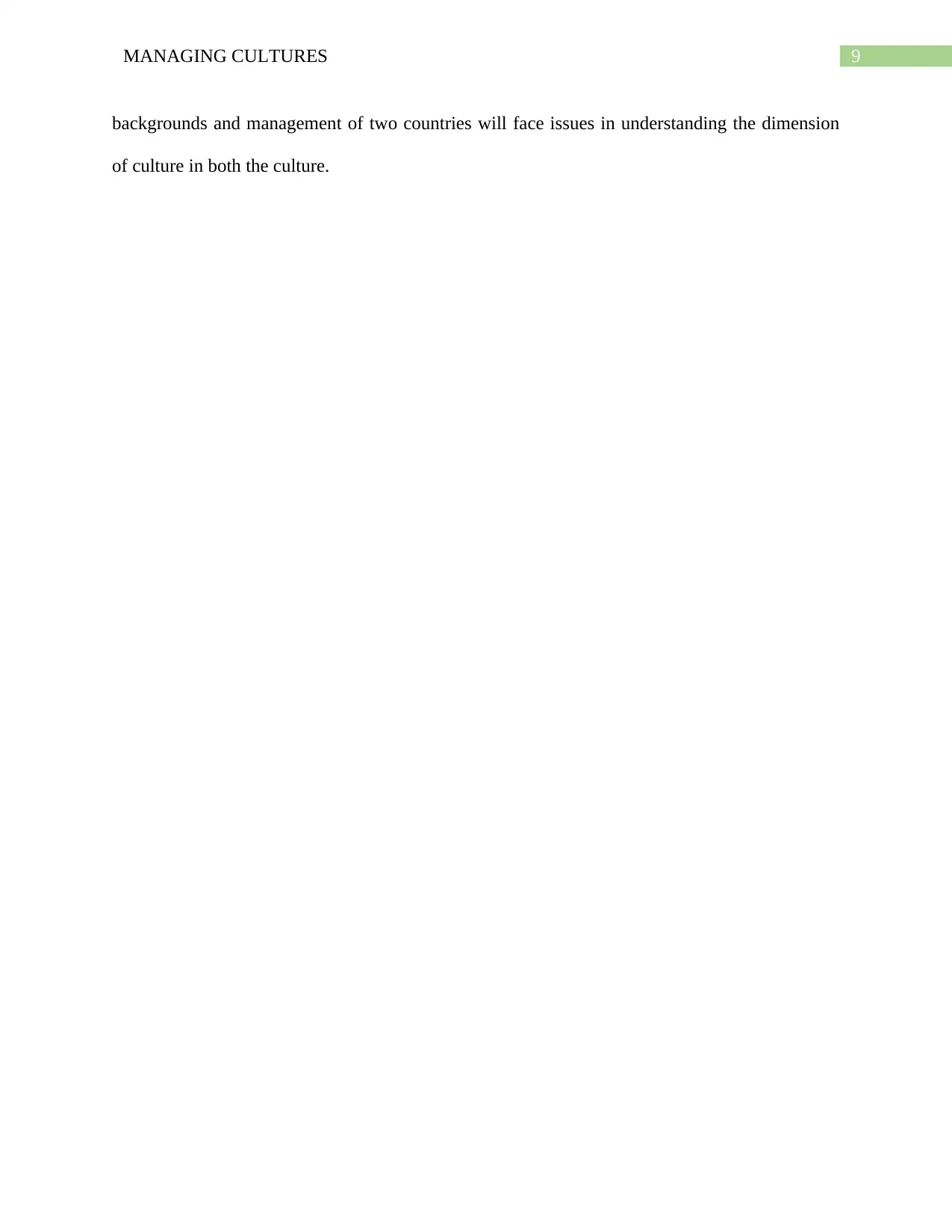
9MANAGING CULTURES
backgrounds and management of two countries will face issues in understanding the dimension
of culture in both the culture.
backgrounds and management of two countries will face issues in understanding the dimension
of culture in both the culture.
Paraphrase This Document
Need a fresh take? Get an instant paraphrase of this document with our AI Paraphraser
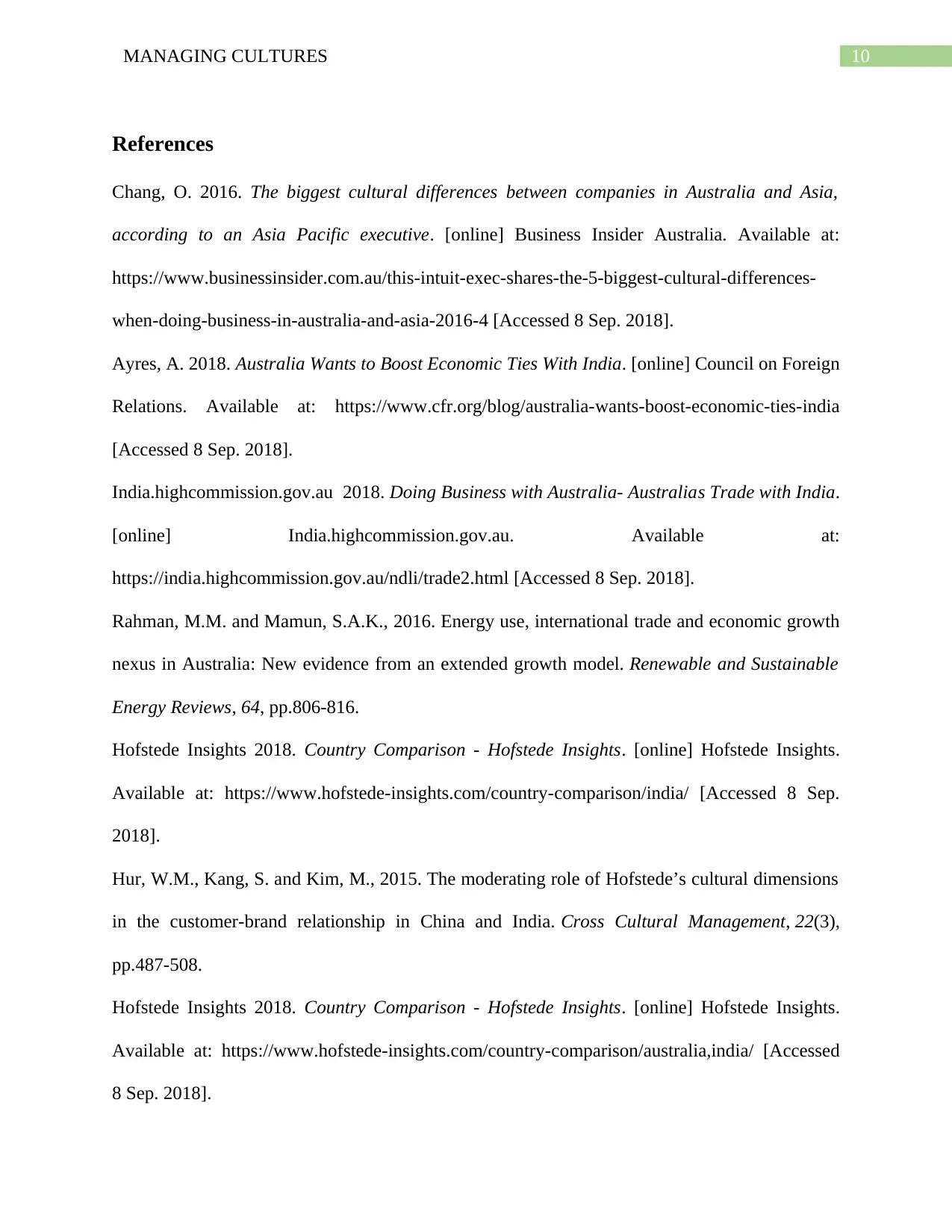
10MANAGING CULTURES
References
Chang, O. 2016. The biggest cultural differences between companies in Australia and Asia,
according to an Asia Pacific executive. [online] Business Insider Australia. Available at:
https://www.businessinsider.com.au/this-intuit-exec-shares-the-5-biggest-cultural-differences-
when-doing-business-in-australia-and-asia-2016-4 [Accessed 8 Sep. 2018].
Ayres, A. 2018. Australia Wants to Boost Economic Ties With India. [online] Council on Foreign
Relations. Available at: https://www.cfr.org/blog/australia-wants-boost-economic-ties-india
[Accessed 8 Sep. 2018].
India.highcommission.gov.au 2018. Doing Business with Australia- Australia s Trade with India.
[online] India.highcommission.gov.au. Available at:
https://india.highcommission.gov.au/ndli/trade2.html [Accessed 8 Sep. 2018].
Rahman, M.M. and Mamun, S.A.K., 2016. Energy use, international trade and economic growth
nexus in Australia: New evidence from an extended growth model. Renewable and Sustainable
Energy Reviews, 64, pp.806-816.
Hofstede Insights 2018. Country Comparison - Hofstede Insights. [online] Hofstede Insights.
Available at: https://www.hofstede-insights.com/country-comparison/india/ [Accessed 8 Sep.
2018].
Hur, W.M., Kang, S. and Kim, M., 2015. The moderating role of Hofstede’s cultural dimensions
in the customer-brand relationship in China and India. Cross Cultural Management, 22(3),
pp.487-508.
Hofstede Insights 2018. Country Comparison - Hofstede Insights. [online] Hofstede Insights.
Available at: https://www.hofstede-insights.com/country-comparison/australia,india/ [Accessed
8 Sep. 2018].
References
Chang, O. 2016. The biggest cultural differences between companies in Australia and Asia,
according to an Asia Pacific executive. [online] Business Insider Australia. Available at:
https://www.businessinsider.com.au/this-intuit-exec-shares-the-5-biggest-cultural-differences-
when-doing-business-in-australia-and-asia-2016-4 [Accessed 8 Sep. 2018].
Ayres, A. 2018. Australia Wants to Boost Economic Ties With India. [online] Council on Foreign
Relations. Available at: https://www.cfr.org/blog/australia-wants-boost-economic-ties-india
[Accessed 8 Sep. 2018].
India.highcommission.gov.au 2018. Doing Business with Australia- Australia s Trade with India.
[online] India.highcommission.gov.au. Available at:
https://india.highcommission.gov.au/ndli/trade2.html [Accessed 8 Sep. 2018].
Rahman, M.M. and Mamun, S.A.K., 2016. Energy use, international trade and economic growth
nexus in Australia: New evidence from an extended growth model. Renewable and Sustainable
Energy Reviews, 64, pp.806-816.
Hofstede Insights 2018. Country Comparison - Hofstede Insights. [online] Hofstede Insights.
Available at: https://www.hofstede-insights.com/country-comparison/india/ [Accessed 8 Sep.
2018].
Hur, W.M., Kang, S. and Kim, M., 2015. The moderating role of Hofstede’s cultural dimensions
in the customer-brand relationship in China and India. Cross Cultural Management, 22(3),
pp.487-508.
Hofstede Insights 2018. Country Comparison - Hofstede Insights. [online] Hofstede Insights.
Available at: https://www.hofstede-insights.com/country-comparison/australia,india/ [Accessed
8 Sep. 2018].
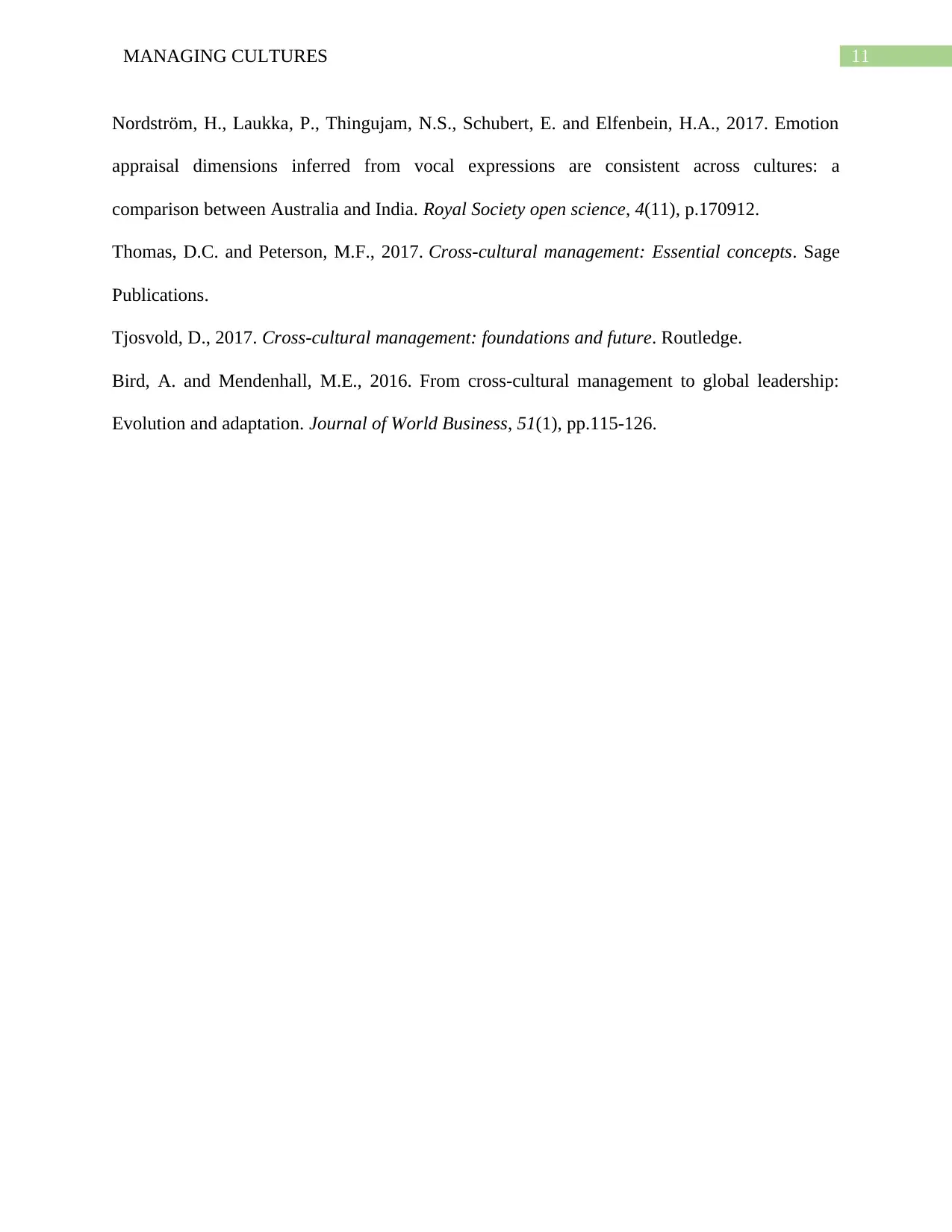
11MANAGING CULTURES
Nordström, H., Laukka, P., Thingujam, N.S., Schubert, E. and Elfenbein, H.A., 2017. Emotion
appraisal dimensions inferred from vocal expressions are consistent across cultures: a
comparison between Australia and India. Royal Society open science, 4(11), p.170912.
Thomas, D.C. and Peterson, M.F., 2017. Cross-cultural management: Essential concepts. Sage
Publications.
Tjosvold, D., 2017. Cross-cultural management: foundations and future. Routledge.
Bird, A. and Mendenhall, M.E., 2016. From cross-cultural management to global leadership:
Evolution and adaptation. Journal of World Business, 51(1), pp.115-126.
Nordström, H., Laukka, P., Thingujam, N.S., Schubert, E. and Elfenbein, H.A., 2017. Emotion
appraisal dimensions inferred from vocal expressions are consistent across cultures: a
comparison between Australia and India. Royal Society open science, 4(11), p.170912.
Thomas, D.C. and Peterson, M.F., 2017. Cross-cultural management: Essential concepts. Sage
Publications.
Tjosvold, D., 2017. Cross-cultural management: foundations and future. Routledge.
Bird, A. and Mendenhall, M.E., 2016. From cross-cultural management to global leadership:
Evolution and adaptation. Journal of World Business, 51(1), pp.115-126.
⊘ This is a preview!⊘
Do you want full access?
Subscribe today to unlock all pages.

Trusted by 1+ million students worldwide
1 out of 12
Related Documents
Your All-in-One AI-Powered Toolkit for Academic Success.
+13062052269
info@desklib.com
Available 24*7 on WhatsApp / Email
![[object Object]](/_next/static/media/star-bottom.7253800d.svg)
Unlock your academic potential
Copyright © 2020–2025 A2Z Services. All Rights Reserved. Developed and managed by ZUCOL.





